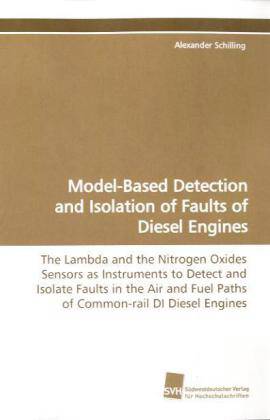
Door een staking bij bpost kan je online bestelling op dit moment iets langer onderweg zijn dan voorzien. Dringend iets nodig? Onze winkels ontvangen jou met open armen!
- Afhalen na 1 uur in een winkel met voorraad
- Gratis thuislevering in België vanaf € 30
- Ruim aanbod met 7 miljoen producten
Door een staking bij bpost kan je online bestelling op dit moment iets langer onderweg zijn dan voorzien. Dringend iets nodig? Onze winkels ontvangen jou met open armen!
- Afhalen na 1 uur in een winkel met voorraad
- Gratis thuislevering in België vanaf € 30
- Ruim aanbod met 7 miljoen producten
Zoeken
Model-Based Detection and Isolation of Faults of Diesel Engines
The Lambda and the Nitrogen Oxides Sensors as Instruments to Detect and Isolate Faults in the Air and Fuel Paths of Common-rail DI Diesel Engines
Alexander Schilling
Paperback | Engels
€ 88,95
+ 177 punten
Omschrijving
The increasingly stringent limitations on emission levels imply more narrow tolerances of operations, such that diesel engines have to be continuously monitored in order to ensure the optimality of the operating conditions. For this purpose, the knowledge of the engine outputs is a fundamental prerequisite. This knowledge could be gained either with real sensors or with virtual ones, i.e., with real-time mathematical models. Currently, the only engine-output sensors commercially available are those for measuring Lambda and the NOx concentration level. The aim of this work is thus to explore the possibilities given by the aforementioned engine- output sensors for the detection and isolation of faults in the air and fuel paths of diesel engines. To achieve this objective a model-based strategy is pursued. First, a mathematical model of the engine is developed. Successively, control-oriented models for the real-time computation of the Lambda value and the NOx concentration are derived from the detailed combustion model. Finally, on the basis of the control-oriented models developed, the fault detection and isolation system is realized.
Specificaties
Betrokkenen
- Auteur(s):
- Uitgeverij:
Inhoud
- Aantal bladzijden:
- 212
- Taal:
- Engels
Eigenschappen
- Productcode (EAN):
- 9783838106878
- Verschijningsdatum:
- 4/05/2009
- Uitvoering:
- Paperback
- Formaat:
- Trade paperback (VS)
- Afmetingen:
- 152 mm x 229 mm
- Gewicht:
- 290 g

Alleen bij Standaard Boekhandel
+ 177 punten op je klantenkaart van Standaard Boekhandel
Beoordelingen
We publiceren alleen reviews die voldoen aan de voorwaarden voor reviews. Bekijk onze voorwaarden voor reviews.











